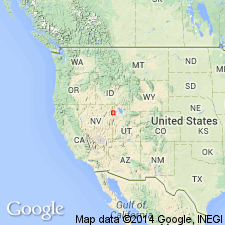
- Usage in publication:
-
- Ola Sandstone*
- Modifications:
-
- Named
- Biostratigraphic dating
- Dominant lithology:
-
- Sandstone
- Siltstone
- Limestone
- AAPG geologic province:
-
- Great Basin province
Summary:
Named derived from Ola, site along Western Pacific Railroad, Ola 7.5' quad, Elko Co, NV. Type section designated as 60-m-thick sequence of ridge to cliff-forming quartz sandstone, calcareous siltstone and silty limestone exposed one km west of Morgan Pass, sec.21 T32N R68E, Morgan Pass 7.5' quad, northern Goshute Mountains, Elko Co, NV. Is equivalent to unit B of Day and others (1987). Also occurs in Deep Creek Mountains of western UT, where uppermost 50 m of Lamb Dolomite is here reassigned to Ola Sandstone on basis of its lithology. Ola Sandstone is distinguished by its yellowish orange to brick red color and quartz sand content. Overlies Lion Spring Limestone (new) and Lamb Dolomite. Underlies Goshute Limestone (new). CREPICEPHALUS Assemblage Zone fauna (trilobites) are contained in unit in Deep Creek Mountains area. In Goshute Mountains both overlying and underlying formations also contain CREPICEPHALUS Assemblage Zone fauna. Thus, Ola Sandstone is considered to be entirely early Late Cambrian in age.
Source: GNU records (USGS DDS-6; Menlo GNULEX).
For more information, please contact Nancy Stamm, Geologic Names Committee Secretary.
Asterisk (*) indicates published by U.S. Geological Survey authors.
"No current usage" (†) implies that a name has been abandoned or has fallen into disuse. Former usage and, if known, replacement name given in parentheses ( ).
Slash (/) indicates name conflicts with nomenclatural guidelines (CSN, 1933; ACSN, 1961, 1970; NACSN, 1983, 2005, 2021). May be explained within brackets ([ ]).

